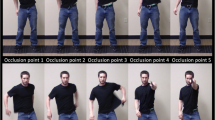Abstract
Even though several studies have shed light on the effect of emotions on cognitive processes such as decision-making, research on naturalistic decision-making has so far been virtually silent on the issue of emotions. The aim of the present research was to investigate how affect states influence the performance of a group of proficient decision-makers, police officers, in the ability to detect armed targets. Specifically, the aim of this research was to investigate the impact of arousal, valence and content of IAPS pictures on rapid decision-making in a shooting task performed under high level of pression and in risky condition. Three versions of a first person shooting tasks (FPST) were performed, manipulating emotional and arousing contents of visual stimuli. Two groups of subjects, civilians and police officers, were presented with the three FPST that varied for pictorial stimuli presentation before the task. Pictorial stimuli were used to elicit specific emotions and to investigate the effect on participants’ performance confronting results for their inter-group performance in the three versions of the task (task 1 vs task 2 vs task 3) and between-groups performance (civilians vs. police officers). Subjects had to perform a task where a rapid decision to shoot or not was requested. Measures of perceptive sensitivity (d’), response bias (c) and reaction times were detected and measured. Findings were consistent with the hypothesis that affective modulation influences response bias activation and performance and that content of stimuli amplifies the effect size. Moreover, whereas police officers resulted able to better control the effect of arousing stimuli and negative affect states than civilians, their latencies were longer, a strategy that could be dangerous and resulting in becoming the victim in an hypothetical shooting incident.





Similar content being viewed by others
References
Barlow DH (2001) Clinical handbook of psychological disorders: a step by-step treatment manual, 3rd edn. The Guilford Press, New York
Barlow DH (2002) Anxiety and its disorders: the nature and treatment of anxiety and panic, 2nd edn. The Guilford Press, New York
Barton J, Vrij A, Bull R (1998) New paradigms in researching police use of firearms. J Police Crim Psychol 13(2):36–41
Beach LR, Mitchell TR, Deaton MD, Prothero J (1978) Information relevance, content and source credibility in the revision of opinions. Organ Behav Human Perform 21(1):1–16
Biederman I (1987) Recognition-by-components: a theory of human image understanding. Psychol Rev 94(2):115–147
Bradley MM, Codispoti M, Cuthbert BN, Lang PJ (2001) Emotion and motivation: defensive and appetitive reactions in picture processing. Emotion 1(3):276–298
Bradley MM, Sabatinelli D, Lang PJ, Fitzsimmons JR, King W, Desai P (2003) Activation of the visual cortex in motivated attention. Behav Neurosci 117(2):369–380
Burrows C (2007) Critical decision making by police firearms officers: a review of officer perception, response, and reaction. Policing 3(1):273–283
Correll J, Park B, Judd CM, Wittenbrink B (2002) The police officer’s dilemma: using ethnicity to disambiguate potentially threatening individuals. J Pers Soc Psychol 83(6):1314–1329
Correll J, Park B, Judd CM, Wittenbrink B, Sadler MS, Keesee T (2007) Across the thin blue line: police officers and racial bias in the decision to shoot. J Pers Soc Psychol 92(6):1006
Kleider HM, Parrott DJ (2009) Aggressive shooting behavior: how working memory and threat influence shoot decisions. J Res Pers 43(3):494–497
Marr D (1982) Vision. W. H. Freeman, San Francisco
Marucci F (2009) Le immagini mentali. Carocci, Rome
Nieuwenhuys A, Oudejans RRD (2011) Training with anxiety: short- and long-term effects on police officers’ shooting behavior under pressure. Cogn Process 12:277–288
Oudejans RRD (2008) Reality-based practice under pressure improves handgun shooting performance of police officers. Ergonomics 51(3):261–273
Oudejans RRD, Pijpers JR (2010) Training with mild anxiety may prevent choking under higher levels of anxiety. Psychol Sport Exerc 11:44–50
Payne KB (2001) Prejudice and perception: the role of automatic and controlled processes in misperceiving a weapon. J Pers Soc Psychol 81(2):181–192
Payne BK, Lambert AJ, Jacoby LL (2002) Best laid plans: effects of goals on accessibility bias and cognitive control in race-based misperceptions of weapons. J Exp Soc Psychol 38(4):384–396
Payne BK, Shimizu Y, Jacoby LL (2005) Mental control and visual illusions: toward explaining race-biased weapon misidentifications. J Exp Soc Psychol 41(1):36–47
Payne BK, Burkley MA, Stokes MB (2008) Why do implicit and explicit attitude tests diverge the role of structural fit. J Pers Soc Psychol 94(1):16–31
Plant EA, Peruche BM, Butz DA (2005) Eliminating automatic racial bias: making race non-diagnostic for responses to criminal suspects. J Exp Soc Psychol 41(2):141–156
Pole N, Best S, Weiss D, Metzler T, Liberman A, Fagan J et al (2001) Effects of gender and ethnicity on duty-related posttraumatic stress symptoms among urban police officers. J Nerv Mental Dis 189:442–448
Pratto F, John OP (1991) Automatic vigilance: the attention-grabbing power of negative social information. J Pers Soc Psychol 61(3):380–391
Rahman M (2007) high velocity human factors: human factors of mission critical domains in nonequilibrium. Human Factors Ergon Soc Ann Meeting Proc 51(4):273–277
Schimmack U, Oishi S (2005) The influence of chronically and temporarily accessible information on life satisfaction judgments. J Pers Soc Psychol 89(3):395–406
Sim JJ, Correll J (2009) Training moderates racial bias in the decision to shoot. Paper presented at the paper presented at the annual meeting midwestern psychological association Chicago: IL
Author information
Authors and Affiliations
Corresponding author
Rights and permissions
About this article
Cite this article
Luini, L.P., Marucci, F.S. Prediction–Confirmation Hypothesis and Affective Deflection Model to account for split-second decisions and decision-making under pressure of proficient decision-makers. Cogn Tech Work 17, 329–344 (2015). https://doi.org/10.1007/s10111-015-0328-0
Received:
Accepted:
Published:
Issue Date:
DOI: https://doi.org/10.1007/s10111-015-0328-0




